 Purple glow in its plasma state | ||||||||||||||||||||||||||
| Hydrogen | ||||||||||||||||||||||||||
|---|---|---|---|---|---|---|---|---|---|---|---|---|---|---|---|---|---|---|---|---|---|---|---|---|---|---|
| Appearance | Colorless gas | |||||||||||||||||||||||||
| Standard atomic weight Ar°(H) | ||||||||||||||||||||||||||
| Hydrogen in the periodic table | ||||||||||||||||||||||||||
| ||||||||||||||||||||||||||
| Atomic number (Z) | 1 | |||||||||||||||||||||||||
| Group | group 1: hydrogen and alkali metals | |||||||||||||||||||||||||
| Period | period 1 | |||||||||||||||||||||||||
| Block | s-block | |||||||||||||||||||||||||
| Electron configuration | 1s1 | |||||||||||||||||||||||||
| Electrons per shell | 1 | |||||||||||||||||||||||||
| Physical properties | ||||||||||||||||||||||||||
| Phase at STP | gas | |||||||||||||||||||||||||
| Melting point | (H2) 13.99 K (−259.16 °C,−434.49 °F) | |||||||||||||||||||||||||
| Boiling point | (H2) 20.271 K(−252.879 °C,−423.182 °F) | |||||||||||||||||||||||||
| Density (at STP) | 0.08988 g/L | |||||||||||||||||||||||||
| when liquid (at m.p.) | 0.07 g/cm3(solid: 0.0763 g/cm3) [3] | |||||||||||||||||||||||||
| when liquid (at b.p.) | 0.07099 g/cm3 | |||||||||||||||||||||||||
| Triple point | 13.8033 K,7.041 kPa | |||||||||||||||||||||||||
| Critical point | 32.938 K, 1.2858 MPa | |||||||||||||||||||||||||
| Heat of fusion | (H2) 0.117 kJ/mol | |||||||||||||||||||||||||
| Heat of vaporization | (H2) 0.904 kJ/mol | |||||||||||||||||||||||||
| Molar heat capacity | (H2) 28.836 J/(mol·K) | |||||||||||||||||||||||||
Vapor pressure
| ||||||||||||||||||||||||||
| Atomic properties | ||||||||||||||||||||||||||
| Oxidation states | common: −1, +1 | |||||||||||||||||||||||||
| Electronegativity | Pauling scale: 2.20 | |||||||||||||||||||||||||
| Ionization energies |
| |||||||||||||||||||||||||
| Covalent radius | 31±5 pm | |||||||||||||||||||||||||
| Van der Waals radius | 120 pm | |||||||||||||||||||||||||
| Other properties | ||||||||||||||||||||||||||
| Natural occurrence | primordial | |||||||||||||||||||||||||
| Crystal structure | hexagonal (hP4) | |||||||||||||||||||||||||
| Lattice constants | a = 378.97 pm c = 618.31 pm (at triple point) [4] | |||||||||||||||||||||||||
| Thermal conductivity | 0.1805 W/(m⋅K) | |||||||||||||||||||||||||
| Magnetic ordering | diamagnetic [5] | |||||||||||||||||||||||||
| Molar magnetic susceptibility | −3.98×10−6 cm3/mol(298 K) [6] | |||||||||||||||||||||||||
| Speed of sound | 1310 m/s (gas, 27 °C) | |||||||||||||||||||||||||
| CAS Number | 12385-13-6 1333-74-0 (H2) | |||||||||||||||||||||||||
| History | ||||||||||||||||||||||||||
| Naming | name means 'water-former' in Greek | |||||||||||||||||||||||||
| Discovery and first isolation | Henry Cavendish [7] [8] [9] (1766) | |||||||||||||||||||||||||
| Named by | Antoine Lavoisier [7] [10] (1783) | |||||||||||||||||||||||||
| Isotopes of hydrogen | ||||||||||||||||||||||||||
| ||||||||||||||||||||||||||
Hydrogen is a chemical element; it has the symbol H and atomic number 1. It is the lightest and most abundant chemical element in the universe, constituting about 75% of all normal matter. Stars, including the Sun, mainly consist of hydrogen in a plasma state, while on Earth, hydrogen is found in water and organic compounds as the gas H2 (dihydrogen), and in other molecular forms. The most common isotope of hydrogen (1H) consists of one proton, one electron, and no neutrons.
Contents
- Properties
- Atomic hydrogen
- Dihydrogen
- History
- 18th century
- 19th century
- 20th century
- Chemistry
- Reactions of H2
- Hydrogen-containing compounds
- Hydrides
- Hydrogen bonding
- Protons and acids
- Occurrence
- Cosmic
- Terrestrial
- Production and storage
- Industrial routes
- Natural routes
- Storage
- Applications
- Petrochemical industry
- Hydrogenation
- Coolant
- Fuel
- Nickel–hydrogen battery
- Semiconductor industry
- Niche and evolving uses
- Safety and precautions
- See also
- References
- Further reading
- External links
Under standard conditions, hydrogen is a gas of diatomic molecules with the formula H2, called dihydrogen, or sometimes hydrogen gas, molecular hydrogen, or simply hydrogen. Dihydrogen is colorless, odorless, non-toxic, and highly combustible.
Hydrogen gas was first produced artificially in the 17th century by the reaction of acids with metals. Henry Cavendish, in 1766–1781, identified hydrogen gas as a distinct substance and discovered its property of producing water when burned; hence its name means 'water-former' in Greek. Understanding the colors of light absorbed and emitted by hydrogen was a crucial part of developing quantum mechanics.
Hydrogen, typically nonmetallic except under extreme pressure, readily forms covalent bonds with most nonmetals, contributing to the formation of compounds like water and various organic substances. Its role is crucial in acid-base reactions, which mainly involve proton exchange among soluble molecules. In ionic compounds, hydrogen can take the form of either a negatively charged anion, where it is known as hydride, or as a positively charged cation, H+, called a proton. Although tightly bonded to water molecules, protons strongly affect the behavior of aqueous solutions, as reflected in the importance of pH. Hydride, on the other hand, is rarely observed because it tends to deprotonate solvents, yielding H2.
In the early universe, neutral hydrogen atoms formed about 370,000 years after the Big Bang as the universe expanded and plasma had cooled enough for electrons to remain bound to protons. Once stars formed most of the atoms in the intergalactic medium re-ionized.
Nearly all hydrogen production is done by transforming fossil fuels, particularly steam reforming of natural gas. It can also be produced from electricity by electrolysis, however this process is more expensive. Its main industrial uses include fossil fuel processing and ammonia production for fertilizer. Emerging uses for hydrogen include the use of fuel cells to generate electricity.











![A dihydrogen complex of iron, [HFe(H2)(dppe)2] . HFe H2 dppe 2.svg](http://upload.wikimedia.org/wikipedia/commons/thumb/8/84/HFe_H2_dppe_2.svg/250px-HFe_H2_dppe_2.svg.png)








